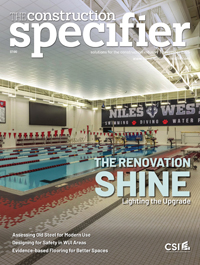Tuning into sound masking technology

Achieving spatial uniformity
Most people compare the sound of a professionally tuned masking system to that of softly blowing air. However, there is much more significance to the tuning process than simply providing a pleasant auditory experience.
A sound masking system’s effectiveness is directly related to its ability to closely match the specified curve. Variations in the masking sound can profoundly impact performance, so a specification not only provides a target curve, but also a tolerance that indicates by how much the sound is allowed to deviate from that curve across the space. Achieving consistency is also important for comfort—a uniform sound fades into the background more easily and occupants come to consider it a natural part of their space.
Historically, tolerance has often been set to ±2 dBA (i.e. plus or minus two A-weighted decibels), giving an overall range of 4 dBA. However, advances in masking technology over the last few decades (described below) allow it to be as low as ±0.5 dBA, or an overall range of 1 dBA.
Measuring the impact
Articulation Index (AI) tests conducted between two workstations illustrate the importance of keeping tolerance as low as possible and consistently meeting the specified sound masking curve throughout the facility.
In this example, two occupants sit approximately 4.7 m (15.5 ft) apart within an open plan. The partitions are 1.6 m (64 in.) in height and the ceiling tile is highly absorptive (Figure 1). However, without sound masking, the ambient level is only 40.6 dBA, and the listener can understand 85 percent of the other person’s conversation. When masking is applied, comprehension quickly declines. In fact, for each decibel of increase in masking volume, comprehension drops by an average of 10 percent. With the masking set to 48 dBA (i.e. the typical maximum level for comfort) with a narrow tolerance of ±0.5 dBA, the listener can understand just 14 to 25 percent. When a broader tolerance of ±2 dBA is applied, he or she can understand up to 59 percent—barely an improvement over the unmasked conditions (Figure 2).
Though this example focuses solely on volume, variations in frequencies can similarly impact masking performance.

Architectural evolution
The importance of spatial uniformity (i.e. achieving tight tuning tolerances throughout the space) is also emphasized by the evolution of sound masking architecture. Since the technology was first introduced in the 1960s, numerous advancements have been made in order to make tuning a more precise and efficient exercise.
Centralized sound masking
The earliest sound masking systems employed a centralized architecture. The name derives from the electronic components used to generate the masking sound (and provide volume, frequency control, and amplification), which are located within an equipment room or closet. The settings established at this central point are broadcast over a large number of loudspeakers—sometimes as many as hundreds. While most offer limited analog volume control at each loudspeaker (usually 4 to 5 settings, in 3-dBA steps), their centralized design means large areas of the facility are nonetheless served by a single set of output settings that offer little or no option for local adjustment.
Technicians have to set each large zone to a level that is best ‘on average,’ because they cannot make precise volume changes in specific areas. Variations in the acoustic conditions across the space and the impact of interior elements cause the masking sound to be too low in some areas and too high in others. If the technician raises the volume to address a performance deficiency in one area, they simultaneously increase it in others because of the sheer size of the zone, which affects occupant comfort. If the technician lowers the volume to boost comfort, they sacrifice speech privacy and noise control. This pattern repeats at unpredictable points across the space, which is why central system specifications typically allow large variations in overall masking volume. Tolerance is typically 4 to 6 decibels (i.e. ±2 to 3 dBA). Further, centralized architecture only provides a global frequency control for each large zone.
Centralized architecture is also prone to a phenomenon called ‘phasing,’ or noticeable variations in the masking level. To try to avoid this problem, technicians employ a dual-channel, interlaced design, ensuring adjacent loudspeakers do not emit the same masking signal. However, it requires two sets of centrally located electronic equipment per zone, which raises the costs.








